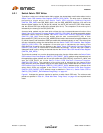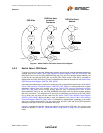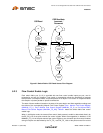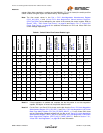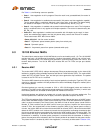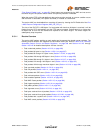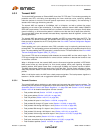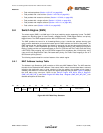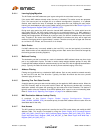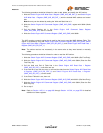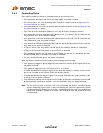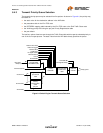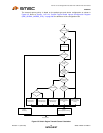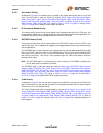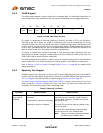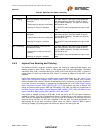
Two Port 10/100 Managed Ethernet Switch with 16-Bit Non-PCI CPU Interface
Datasheet
Revision 1.4 (08-19-08) 64 SMSC LAN9311/LAN9311i
DATASHEET
6.4.1.1 Learning/Aging/Migration
The ALR adds new MAC addresses upon ingress along with the associated receive port.
If the source MAC address already exists, the entry is refreshed. This action serves two purposes.
First, if the source port has changed due to a network reconfiguration (migration), it is updated.
Second, each instance the entry is refreshed, the aging status bit is set, keeping the entry active.
Learning can be disabled per port via the Enable Learning on Ingress field of the Switch Engine Port
Ingress Configuration Register (SWE_PORT_INGRSS_CFG).
During each aging period, the ALR scans the learned MAC addresses. For entries which have the
aging status bit set, the ALR simply clears the bit. As mentioned above, if a MAC address is
subsequently refreshed, the aging bit will be set again and the process would repeat. If a learned entry
already had its aging status bit cleared (by a previous scan), the ALR will instead remove the learned
entry. Therefore, if two scans occur before a MAC address is refreshed, the entry will be aged and
removed. Each aging period is approximately 5 minutes. Therefore an entry will be aged and removed
at a minimum of 5 minutes, and a maximum of 10 minutes.
6.4.1.2 Static Entries
If a MAC address entry is manually added by the host CPU, it can be (and typically is) marked as
static. Static entries are not subjected to the aging process. Static entries also cannot be changed by
the learning process (including migration).
6.4.1.3 Multicast Pruning
The destination port that is returned as a result of a destination MAC address lookup may be a single
port or any combination of ports. The latter is used to setup multicast address groups. An entry with
a multicast MAC address would be entered manually by the host CPU with the appropriate destination
port(s). Typically, the Static bit should also be set to prevent automatic aging of the entry.
6.4.1.4 Address Filtering
Filtering can be performed on a destination MAC address. Such an entry would be entered manually
by the host CPU with the Filter bit active. Typically, the Static bit should also be set to prevent
automatic aging of the entry.
6.4.1.5 Spanning Tree Port State Override
A special spanning tree port state override setting can be applied to MAC address entries. When the
host CPU manually adds an entry with both the Static and Age bits set, packets with a matching
destination address will bypass the spanning tree port state and will be forwarded. This feature is
typically used to allow the reception of the BPDU packets while a port is in the non-forwarding state.
Refer to Section 6.4.5, "Spanning Tree Support," on page 70 for additional details.
6.4.1.6 MAC Destination Address Lookup Priority
If enabled in the Switch Engine Global Ingress Configuration Register
(SWE_GLOBAL_INGRSS_CFG), the transmit priority for static MAC address entries is taken from the
associated data of that entry.
6.4.1.7 Host Access
The ALR contains a learning engine that is used by the host CPU to add, delete, and modify the MAC
Address Table. This engine is accessed by using the Switch Engine ALR Command Register
(SWE_ALR_CMD), Switch Engine ALR Command Status Register (SWE_ALR_CMD_STS), Switch
Engine ALR Write Data 0 Register (SWE_ALR_WR_DAT_0), and Switch Engine ALR Write Data 1
Register (SWE_ALR_WR_DAT_1).



